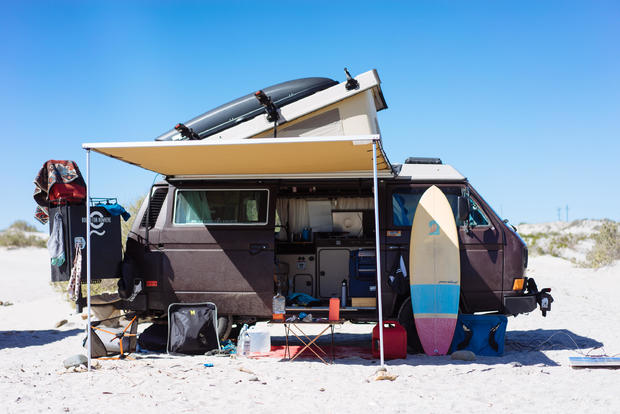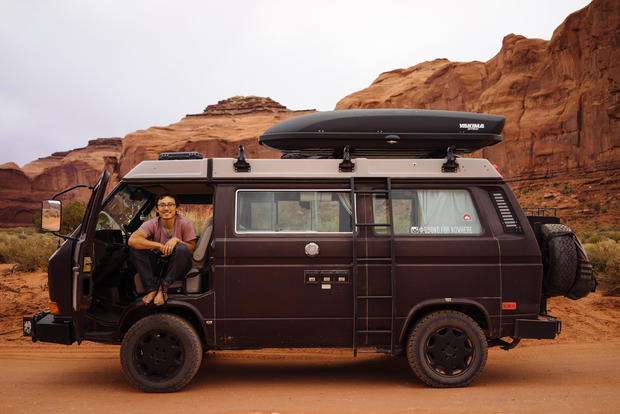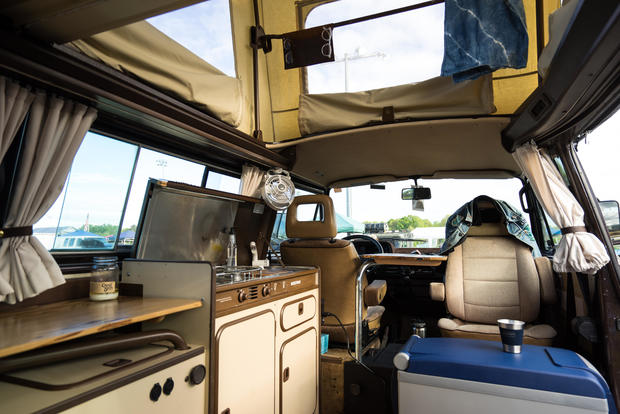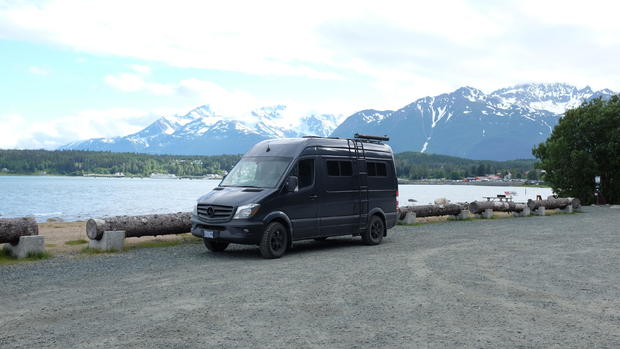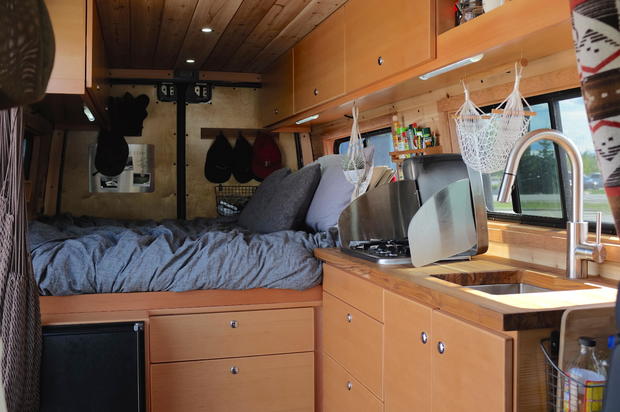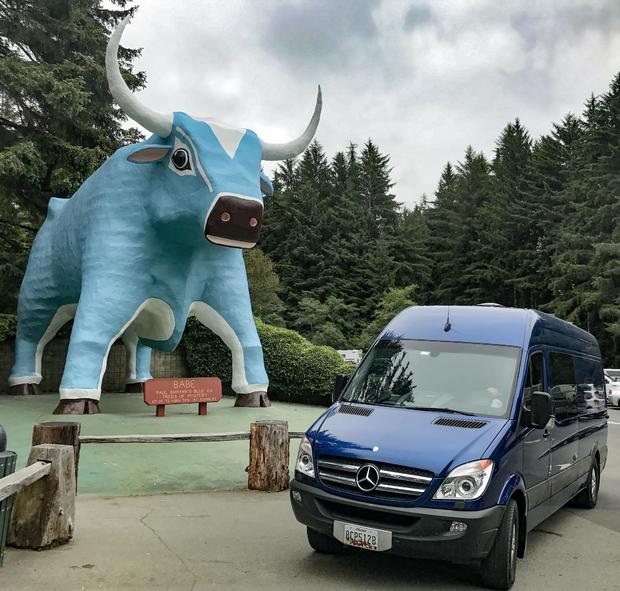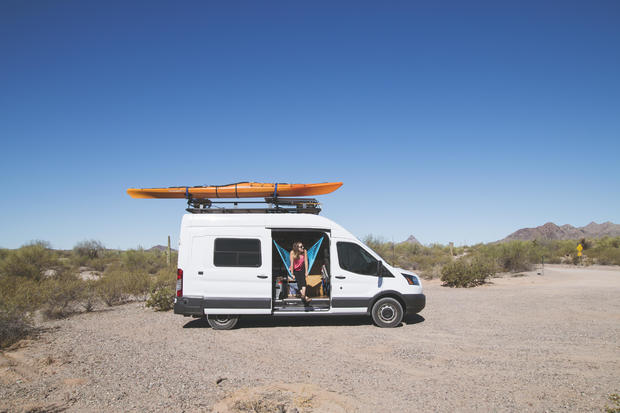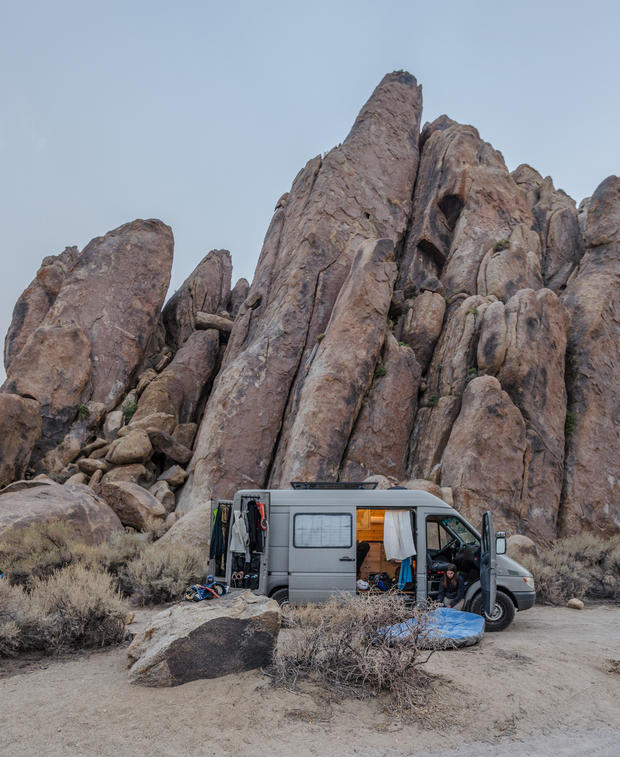5 van homes that take "glamping" on the road
"Van life" is a movement -- and a social media trend -- started by people who want to live simply and travel freely by downsizing their lives into converted cargo vans.
But living in these homes on wheels isn't exactly roughing it. Taking cues from the glamorous camping (or "glamping") and micro-housing trends that have also gained popularity over the past few years, these vehicles often feature creature comforts found in stationary houses -- like refrigerators, toilets and gas stovetops. They also sport inviting décor that would make any aspirational Instagrammer jealous.
Some van owners utilize the tiny abodes for temporary trips, but others have used them as full-time starter homes that help reduce living expenses and allow for flexible career paths.
Freedom from traditional housing payments makes it financially possible for many of these travelers to explore, ditch the cubicle and get in touch with the natural world. But there can be significant upfront costs.
The good news for van-life hopefuls is that it's easy to prioritize and select vehicles, custom features and finishes to fit almost every individual budget and lifestyle. Van conversion projects can cost anywhere from $16,000 to $65,000 and can take years to finish, depending on how "DIY" owners choose to go.
These homeowners often find large communities on social media platforms like Instagram, where many have thousands of followers and learn from each other's experiences. They share images, stories and advice using hashtags like #homeiswhereyouparkit, #exploremore and, of course, #vanlife.
Some of the most popular van lifers secure sponsorships from food or outdoor lifestyle brands, thanks to their large social media followings, but most simply enjoy sharing their passion with others.
"The crazy thing about all this is that Instagram has been a huge driver for everything," said van-home owner Mike Shisler. "The whole van-life community lives on Instagram. Years ago, that's how we found another couple living in a van that inspired us to do it."
But these communities don't always stay online. Van lifers can also be found flocking together at campgrounds, and there are even outdoor festivals that incorporate van-life villages.
Dreaming of a life on the road? Click ahead to see five converted vans and the people who call them home.
1985 Volkswagon Vanagon Westfalia
Instagram: @bound.for.nowhere
Mary Ashley Krogh "MAK" and Owen Chikazawa have been living out of their 1985 Volkswagon Vanagon Westfalia, nicknamed Stanley, since 2016. The van came partially renovated when Krogh and Chikazawa bought it in 2015 for $7,000. A new engine and additional renovation to the interior and exterior brought their total up to about $45,000 for their first home.
"It's an unfortunately high number," Owen said about the total cost for their van build. "If you're buying a vehicle that doesn't require the mechanical upfront to ensure reliability, you can do it a lot cheaper."
1985 Volkswagon Vanagon Westfalia
The pair spent a little over a year finishing the work on their van and did all but the engine swap themselves. It sleeps four people and features solar paneling, a folding couch bed, wooden floors and a swiveling desk.
Going "DIY" was important to the couple. They wanted to get to know their vehicle and learn how to make repairs in case they found themselves on the road alone.
Krogh and Chikazawa both maintain full-time freelance design careers to support their mobile lifestyle. They spent time after college traveling on their savings, and when they decided to transition into van living, they launched their professional lives.
"We wanted to continue to grow our business and progress through our career," said Krogh, "but also travel and enjoy our free time as much as possible."
2016 Mercedes Sprinter
Instagram: @s0weboughtavan
Evan Larson and Katie Larsen are new to living out of a converted van. In October 2016, they purchased their new 2016 Mercedes Sprinter for around $42,000. The decision to buy new came after months of searching through used vehicles and realizing that avoiding maintenance issues and getting all the features they wanted was worth the extra cash.
The home has a two-burner propane stove, butcher block countertop, stainless steel sink, doorway hammock and solar panels.
"Our biggest thing is we wanted it to look and feel like a home," Larson said.
2016 Mercedes Sprinter
The couple did many parts of the conversion -- including insulation, ventilation and wiring -- themselves. They also had help from other experts they knew. Larson's dad helped with many parts of the build, and the couple recruited their friends and other family members to help install new windows (which they purchased the van without) and build cabinetry.
All in all, the project cost about $20,000 and took about six months to complete.
The pair has been on the road since late June 2017. They spent time planning and budgeting for what their lifestyle would be like once they quit their jobs and sold many of their belongings
"We wanted to at least have enough funds to do it for a year," Larson said.
After that year, they said they will consider seasonal and part-time work in order to continue living in their van home.
2013 Mercedes Sprinter
Instagram: @van.there
Jess and Mike Shisler have been on the road in their 2013 Mercedes Sprinter cargo van since April of this year. They bought it in October 2016 with the goal of finishing their conversion and starting their journey in time to celebrate their first wedding anniversary. The Shislers spent five months converting the van, which now features a propane stove, small refrigerator, sink, composting toilet and solar panels.
"We saved so much money doing it ourselves," Jess said.
2013 Mercedes Sprinter
While the couple budgeted $10,000 for their conversion, they spent closer to $15,000. It wasn't always easy trying to work on the project in downtown Baltimore where they lived. With no place to park at their former home, they had to rent a parking spot and a storage locker where they could complete the work on their build.
The Shislers' careers have continued since they started traveling, but working remotely has changed their day-to-day tasks and financial lives significantly. Jess has a freelance science communications position, working 10 to 15 hours a week for the same company where she was employed prior to embarking.
Mike, who has a background in architecture, is an artist who sells his drawings on Etsy as an additional source of income.
Ford Transit 250
Instagram: @vannathetransit
For Laura Hughes and Shane Eubank, living out of their Ford Transit 250 took nearly three years of planning and preparation. The couple has been living full-time in their van, nicknamed Vanna White, since April 2017.
"We wanted to have a slow and thoughtful process," said Hughes.
The couple opted for a new van that cost around $40,000 and put around $15,000 into the conversion.
"I'd say this is the equivalent of having your first child," Hughes said. "We really decided to not be super frugal about it."
Ford Transit 250
Hughes and Eubank did most of the conversion themselves, aside from projects that required cutting a hole in the body of the van. They are particularly proud of the cedar plank walls -- with each piece custom-cut to fit the asymmetrical interior of the van -- which Hughes said makes the van feel very cozy.
It also features a sink, doorway hammock and "roof rack," which provides solar power, extra storage and seating when the van is not in motion.
"[We] have a joke where we built everything twice," Hughes said, "and it turned out to be incredibly true."
Hughes and Eubank saved money leading up to their trip, assuming they would not be working for a while. However, it only took a couple months before Hughes wanted to dive back into her career. She now does freelance writing and photography, while Eubank is spending time studying as he considers going back to school. They're glad for the time they spent saving, however.
"The key was saving up the money so we could be flexible," Hughes said.
2006 Dodge Sprinter
Instagram: @onechicktravels
Kaya Lindsay has been living out of her 2006 Dodge Sprinter van since the end of June 2016. Kaya and her boyfriend Michael bought it in February 2016, partly as a solution to the expensive housing in Santa Cruz, California, where they lived. The van itself cost them about $11,000 and they spent around $5,000 to finish the project.
They did most of the conversion themselves, with the exception of a few more challenging details (like prepping the butcher block countertop). It now has solar panels, wooden floors, a sink, small refrigerator, bike mount and swivel seats. Lindsay is also particularly proud of the wood paneling in her van, which she said helps the van feel more like home.
"I've seen a lot more people with the wood paneling in the van," she said. "I don't know if I can take credit for that, but I'm hoping it's something people start doing."
2006 Dodge Sprinter
Lindsay works as a freelance social media marketer, which allows her to keep working whether she's parked in the driveway of a loved one's house or out on the road.
"I like it a lot," she said, "it works really well with my lifestyle."
Lindsay also spends time maintaining her website, Instagram and YouTube channel, where she shares videos about the conversion process and her life in a van.
"I kind of wanted to show people that it is possible to do it on a budget," she said. "For being a first-time homeowner at 24 and living and working and traveling, I wanted to show people that it is possible and you can do it yourself."
